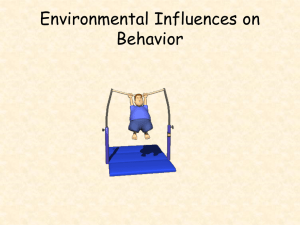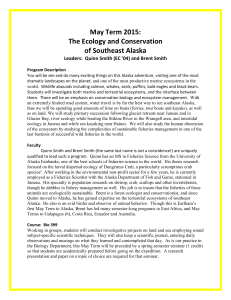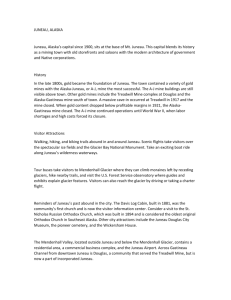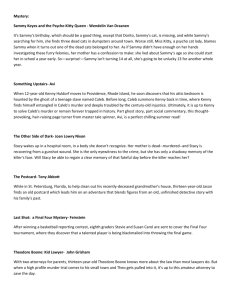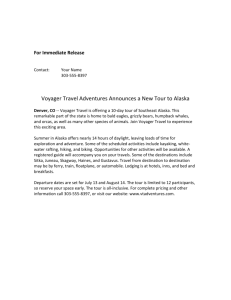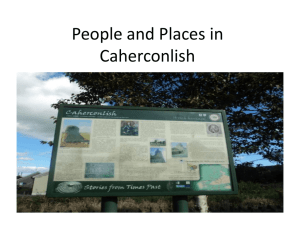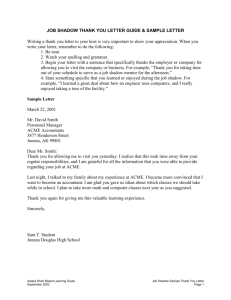Abstract:
advertisement
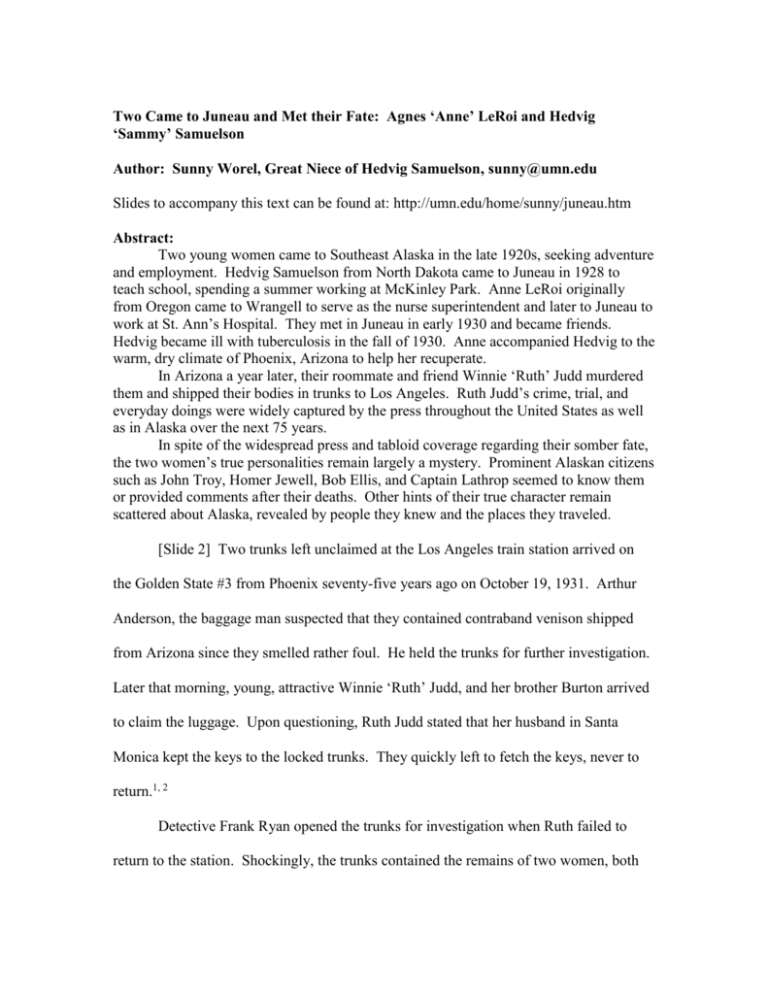
Two Came to Juneau and Met their Fate: Agnes ‘Anne’ LeRoi and Hedvig ‘Sammy’ Samuelson Author: Sunny Worel, Great Niece of Hedvig Samuelson, sunny@umn.edu Slides to accompany this text can be found at: http://umn.edu/home/sunny/juneau.htm Abstract: Two young women came to Southeast Alaska in the late 1920s, seeking adventure and employment. Hedvig Samuelson from North Dakota came to Juneau in 1928 to teach school, spending a summer working at McKinley Park. Anne LeRoi originally from Oregon came to Wrangell to serve as the nurse superintendent and later to Juneau to work at St. Ann’s Hospital. They met in Juneau in early 1930 and became friends. Hedvig became ill with tuberculosis in the fall of 1930. Anne accompanied Hedvig to the warm, dry climate of Phoenix, Arizona to help her recuperate. In Arizona a year later, their roommate and friend Winnie ‘Ruth’ Judd murdered them and shipped their bodies in trunks to Los Angeles. Ruth Judd’s crime, trial, and everyday doings were widely captured by the press throughout the United States as well as in Alaska over the next 75 years. In spite of the widespread press and tabloid coverage regarding their somber fate, the two women’s true personalities remain largely a mystery. Prominent Alaskan citizens such as John Troy, Homer Jewell, Bob Ellis, and Captain Lathrop seemed to know them or provided comments after their deaths. Other hints of their true character remain scattered about Alaska, revealed by people they knew and the places they traveled. [Slide 2] Two trunks left unclaimed at the Los Angeles train station arrived on the Golden State #3 from Phoenix seventy-five years ago on October 19, 1931. Arthur Anderson, the baggage man suspected that they contained contraband venison shipped from Arizona since they smelled rather foul. He held the trunks for further investigation. Later that morning, young, attractive Winnie ‘Ruth’ Judd, and her brother Burton arrived to claim the luggage. Upon questioning, Ruth Judd stated that her husband in Santa Monica kept the keys to the locked trunks. They quickly left to fetch the keys, never to return.1, 2 Detective Frank Ryan opened the trunks for investigation when Ruth failed to return to the station. Shockingly, the trunks contained the remains of two women, both shot in the head at close range. Somebody severed one woman above the hips, and below the knees, apparently for ease in packing. The other woman was folded intact at the bottom of the larger steamer trunk. Personal effects in the trunks including pictures, letters, work contracts, and a diploma quickly identified the two women: Agnes ‘Anne’ LeRoi and Hedvig ‘Sammy’ Samuelson.3, 4 [Slide 3] It is remarkable how a single change of plans has the potential to change the course of a person’s life. The women left Juneau a year earlier on the steamship Admiral Rogers. Sammy returned from a summer of study at the Chicago Normal School, ready for her third year of teaching in the Juneau elementary school. After being back in Juneau for a month, she discovered that she had contracted tuberculosis. Anne, a nurse and friend working at St. Ann’s hospital in Juneau quit her job to accompany her south to a drier climate.5 Anne thought she could find work and care for Sammy as well. x-rays taken in Seattle revealed that Anne had contracted a mild case of tuberculosis herself.6 The women who originally sailed for Laguna Beach California headed for the hot, dry climate of Phoenix, Arizona. Anne LeRoi found work as an x-ray technician at the newly opened Grunow Clinic and nursed Sammy at their shared duplex in early 1931. Sammy’s care included total bed rest as prescribed by a common book of tuberculosis found in their home.7, 8 Ruth worked at the Grunow Clinic herself as a secretary as her husband struggled with an addiction to morphine that ruined his chances for stable health and employment. Ruth took over the residence at the duplex during the summer while Anne LeRoi returned to Portland to visit her family and to receive medical treatment. Sammy moved in with her 2 near the end of the summer in 1931. When Anne returned, the three women lived together, all trying to make it under difficult circumstances.9 [Slide 4] Two conflicting stories tell of the two girls’ fate. The most commonly told story by Ruth Judd, was that the three women had some differences while they lived together that caused her to move out in early October 1931. The exact nature of this quarrel remains undefined but may have included themes such as jealousy over a certain married man, threats to reveal secrets about one another, or even a disagreement about Ruth’s pet cat. Whatever the cause, Ruth claimed that Sammy threatened her with a gun. The two struggled for the gun while Anne struck Ruth over the head with an ironing board. Ruth wrestled the gun from Sammy and shot both girls. An unnamed person dismembered Sammy’s body for ease in packing and Ruth traveled to Los Angeles with the trunks by train.10 In contrast, in the initial trial, the state attorney argued that Ruth shot both women in bed in a jealous rage as they slept.11 The jury found her guilty. [Slide 5] The initial crime was over but effects of the aftermath have lasted for seventy-five years. The State of Arizona tried Ruth and sentenced her to hang. Later the state declared her insane and sent her to the state hospital where she escaped seven times over thirty years. Newspapers, especially tabloids and Hearst papers faithfully revisited the story after each of Ruth’s escapes and her eventual pardon in 1971. Truth seemed to be lost as papers dwelled on the grisly details of the crimes as well as the reputed peculiarities of the characters involved. For Anne LeRoi and Sammy Samuelson, their true personalities were all but lost to history. [Slide 6] Violent crime affects those who remain for several generations. In the case of Sammy’s immediate family, they took the “stiff arm” when it came to dealing 3 with questions from family and friends.12 Tired of seeing the story retold in the press so continually, Arnold Samuelson, Sammy’s brother stated that “The survivors of the victim are themselves the helpless victims….the only thing we could do was try to survive and get our minds on to other things.”12 Thus, they rarely spoke much about Sammy, which meant contemporary generations lost nearly any knowledge about her. Photo albums contain pictures with vague definition, but explain little about who she was in her lifetime. [Slide 7] Sammy came to Juneau in the fall of 1928, to teach 3rd and 4th grade in the Juneau public elementary school. She arrived on the Princess Charlotte in September of 1928 after teaching for two years at Whitehall, Montana.13, 14 The elementary school was located between 5th and 6th street between Seward and Franklin Streets until it burned down in 1973. An average of 450 students enrolled at this school between the years of 1928-1930.15 Teachers received a starting salary of about $1260 for a nine month contract in 1930.16 According to her brother Arnold, she was chosen for this job over three hundred other applicants.12 [Slide 8] For at least part of her time in Juneau, she made the Gastineau Hotel on Franklin Street her home.17 Teachers often lived here, sharing a common bath and simple accommodations. In the early Thirties, a room here including breakfast cost about thirtyfive dollars a month. The hotel allowed simple cooking on a hotplate for other meals. Near the back of the building, miners could be seen late at night as they left the A-J mine, their carbide headlamps appearing like fireflies descending from the hills.16 The Gastineau Hotel is now apartments in Juneau. 4 [Slide 9] Mabel Monson Burford, the Minnesota teacher who replaced Sammy in the school system, stated that teachers often left school promptly at 5 to walk up Old Basin Road to prepare coffee and hotdogs for dinner.16 Being avid hikers on weekends, they often trekked up the Perseverance Trail or down Thane Road to the waterfalls. Sammy definitely enjoyed the hike up to the Ebner Falls on the Perseverance Trail and up Old Basin Road as shown by family photographs. The Alaska Gastineau Mining Company ceased operations at the Perseverance Mine in 1921, but the A-J mine bustled with activity in the Gold Creek area during this time. [Slide 10] Sammy’s cousin Ida Nelson stated, “Hedvig was strong for outdoor sports. She liked to skate, ride horseback, hike, and picnic. She liked other sports too, and dancing, but she cared most for the outdoors. Her favorite pastime was skating.”18 The lake in front of the Mendenhall Glacier offered a great opportunity to skate in Juneau. In the Thirties, skaters could glide directly up to the glacier’s vertical face and touch the glacier. Today, the glacier appears flatter, having retreated away from the lake although it remains a popular skating destination.19 [Slide 11] Summertime for teachers in Alaska often meant adventure and travel. During the summer of 1929, Sammy and music teacher Dorothy Chisholm traveled into the interior together, reaching McKinley Park. There they parted ways. Sammy stayed for a while and later left to visit Fairbanks. She returned to the park as an employee and remained for the rest of the summer.20 She was reputed to be very popular among the tourists visiting the park.21 She reflected about her time in the park later in a letter, “Spent one summer way up in the interior. There were plenty of mountain sheep, fox, caribou, grizzly bears, etc. to make it interesting.” 22 Family photographs reveal Sammy 5 in a park ranger style uniform, sitting upon a dogsled which was used to patrol the park during winter. Harry Karstens, park superintendent, had built the current dog kennels at the park close to this time. However, sled dog demonstrations for tourists performed by park staff did not commence until 1939.23 She returned to Juneau in the fall bringing with her gold dust she had panned from a placer mine giving “proof of her experience” from her summer travels.20 [Slide 12] The summer of 1929 was a time of change for McKinley Park. During that summer, the Alaska Road Commission made steady progress with the road into the park, moving tent camps as they worked.24 The park employees constructed new log buildings and installed a new water system. The new superintendent Harry Liek thought Mount McKinley really needed more tourists, especially in regards to future appropriations. He developed a new guide lecture service for tourists. The summer of 1929 was also known as the worst year for mosquitoes in twenty years. By August, everybody was wearing mosquito nets.25 [Slide 13] It is possible that Sammy knew Superintendent Harry J. Liek from the previous summer, both having been at Yellowstone in 1928. Harry Liek had been a ranger associate at Yellowstone Park. Superintendent Horace Albright had recommended him to replace Harry Karstens as superintendent at McKinley Park with the future development of the park in mind.26 Sammy left Whitehall Montana where she was teaching during the school year and planned on spending the summer at Yellowstone Park.27 After her death, an Alaskan newspaper stated that she had come to Alaska directly from Yellowstone.28 At least a few other Whitehall locals motored to the park in early June intending to spend the summer working. Sammy may have been with them.29 If so, 6 Harry Liek may have been her connection for obtaining employment during the summer of 1929 at McKinley Park. [Slide 14] Anne LeRoi, a Portland nurse, traveled to Wrangell in October 1929 and became the superintendent at the Wrangell General Hospital where she served with another nurse, Sarah Elizabeth Hart.30, 31 In February of 1930, Anne LeRoi moved to Juneau to work at St. Ann’s hospital. She originally registered at the Alaskan Hotel just a block from the Gastineau Hotel where Sammy lived.32 [Slide 15] Anne LeRoi and Sammy Samuelson met on February 15, 1930 during a Juneau blizzard and became friends.33 It is unknown under the exact conditions that they met. One source stated that they originally met at the hospital in Wrangell instead.34 However, they were living and working within a few blocks from one another in Juneau early 1930. Sammy wrote in her diary a year later, “Just think, it’s been just a year since I met Anne. It seems that I knew her always.”33 A family photograph shows the pair in winter standing facing the Juneau elementary school on Franklin Street. The picture clearly shows historical buildings such as the Sweeney Apartments and St. Nicholas Russian Orthodox Church in the background. [Slide 16] The two women became close friends even though they did not know each other for any great length of time. Sammy left Juneau on June 13 to attend the Chicago Normal School for the summer, not returning until August 26.35-37 They left together on October 2, a little over a month later on the steamship Admiral Rogers.5 They were together in Juneau for only about four months. The two girls were well known and well liked. According to the Juneau Empire, “news of the tragedy appalled both child and adult, especially as regarded Miss 7 Samuelson who was so favorably and widely known.”38 The Juneau paper also stated that Anne, a popular nurse had a whole host of friends in Juneau.39 The Alaska Weekly stated that former Alaskans in Seattle stated that everybody who knew Sammy and Anne “loved them and regarded them highly.”6 Newspapers from around the country contained quotes and testimonies by many people who knew them. Perhaps the notoriety of the crime caused people they barely knew to make statements. It is possible however, in a small state capital like Juneau, that they knew many prominent Alaskans. [Slide 17] An article in the Anchorage Daily Times stated that former Juneau residents Mr. and Mrs. Bob Ellis knew Sammy.40 Bob Ellis, aviator, navigated the first Seattle to Juneau non-stop flight on April 15, 1929 and later founded Ellis Airlines in Ketchikan. Soon after his historic flight, he started flying passengers for twenty minutes over the glacial ice cap for ten dollars a head in his seaplane.41 Sammy wrote that she had viewed Juneau from above in planes through friends she had known in Juneau. She wrote to some friends in Landa, ND while she was sick in Phoenix, “In Juneau, we did a lot of plane riding, friends of mine being connected with the airways. It is the best way to see the country, flying over immense glaciers, lakes, and mountains, gives one the most wonderful thrills.” 22 Plane travel was somewhat new in Southeast Alaska during this time. It is possible that Sammy flew with Bob Ellis in his seaplane sometime between 1929 and 1930. [Slide 18] Alaskan political figures such as John Troy apparently knew Sammy and helped raise money for her departure from Juneau. Alaska Governor John Troy, at the time was publisher of the Daily Alaska Empire. He described Sammy as a “little beam of sunshine” after her death. 42 When she suddenly needed to leave Juneau after 8 contracting tuberculosis, she was without funds since she had just returned from her summer in Chicago. Anne LeRoi volunteered to take Sammy to Arizona since she thought she could obtain work there and “we paid the expenses of both of them,” Troy said.42 Other stories offer conflicting reports about funding, stating that the funds were actually raised by the board of education and the school teachers of Juneau or by the general Juneau townspeople themselves.6, 43 [Slide 19] Captain Lathrop was a wealthy Alaskan theater owner, moviemaker, miner, newspaper publisher, and political figure who knew Sammy and minimally offered her financial aid. ‘Cap’ reputably raised 1000 dollars to help Sammy claimed one newspaper.44 Another story stated, “A rich Alaskan who owned a chain of theaters and newspapers and was a power in politics raised 1000- some say 2500-” for Sammy.45 A letter Sammy wrote on her last morning alive to her sister Anna hinted at a financial connection with ‘Cap’ Lathrop: Really, Anna there are some people in this world that are so kind that they make up for all the selfish ones. Dear old Capt Lathrop sent me the sweetest letter wanting me to be sure to write and tell him if I needed financial aid. He will be in Seattle by Nov 1, but that's a long ways from here.46 Evelyn Nace, a nurse friend in Phoenix of both of the girls stated that Sammy was supporting herself with two – five hundred dollar loans.47 It is entirely possible that Captain Lathrop aided Sammy and Anne LeRoi by either giving them money or loans. [Slide 20] Perhaps the most outrageous claim to fame was that Sammy somehow knew John Barrymore and his wife Dolores Costello of the silver screen. Several newspapers stated Sammy had been invited to take a cruise with them once she recovered in Arizona on their yacht Infanta.44, 48 The Barrymores vacationed in Alaska waters in June of 1931, “seeking rest” while Sammy lay ill in Arizona.49 A “society woman”, 9 June Cann, living in Seattle wrote a letter to Sammy in September 1931 stating, “John and Dolores Barrymore visited us for 27 days on their yacht, Infanta and it was sure fun to have them, and if we go south this winter they want us to visit them in Beverly Hills. Could you go along with us on our yacht?” 50 June Cann was the one who apparently knew the Barrymores. There is a clue to who Mrs. June Cann was. Sammy’s diary contained a list of addresses in the back including: Mrs. J. Cann, The Northcliff Apartments, 308 West, corner Seneca and Boren, Seattle, WA.45 However, the 1930 US census lists James Cann, married with no occupation, at the Gastineau Hotel, the same place that Sammy lived.17 James Cann actually owned part of the hotel, but his family lived elsewhere. He sold his share of the Hotel to John Biggs in May of 1930. He hoped to reunite with his family and resume mining activities at Apex-El Nido.51 This explains at least partly the connection between Sammy, the Canns, and the Barrymores. [Slide 21] Other unanswered Alaskan mysteries remain. Homer Jewell, former game warden of Juneau, stated that he knew her.40 Anthony Dimond, who at the time was territorial senator, was said to have sent letters of good cheer to Sammy while she lay ill in Arizona.44 Sammy met a prominent man “from the East” on a steamer who wrote to her for months and talked about sending her books and money.45 In addition, several unnamed people in Valdez claimed to know Sammy well.52 The girls’ departure from Juneau radically defined their own personal history. However, their fates both created and lost other history. Immediate family rarely spoke much about Sammy and her contemporary relatives know very little about her. Sammy kept a diary while she rested in Arizona which was lost through the courts and to the 10 newspapers.53, 54 Mabel Monson Burford who replaced Sammy in the school system was so upset by reading Sammy’s diary entries in the Daily Alaska Empire, she tossed her own diary overboard while on the steamship Yukon for fear that her life might someday become so public.55, 56 Prominent Alaskan citizens seemed to know them or provided comments after their deaths perhaps for reasons of notoriety. Other hints of their true character remain scattered about Alaska, hinted at by people they knew, their photographs, and the places they traveled. In spite of the widespread press and tabloid coverage regarding their fate, the two women’s true personalities remain largely a mystery. References: 1. 2. 3. 4. 5. 6. 7. 8. 9. 10. 11. 12. 13. 14. Davidson, DA and P Stevens, Los Angeles Police Department Officers Report Concerning Bodies Found in Trunk DR#607337, in Winnie Ruth Judd Papers, Arizona State Archives, October 19, 1931: Phoenix. Reporters Transcript 11-9-31 A.M.: Testimony of Arthur Anderson, in State vs Judd, November 9, 1931: Phoenix. Davidson, DA and HL Barlow, Los Angeles Police Department Report: Officers Report Regarding Homicide Investigation., in Winnie Ruth Judd Collection. Arizona State Archives, October 19, 1931: Phoenix. Bodies of Two Murdered: Women Hid in Luggage, in Los Angeles Times, October 20, 1931: Los Angeles. p. 2. Ailing Teacher Leaves Here for California, in Daily Alaska Empire, October 2, 1930: Juneau, AK. p. 8. Two Former Alaska Girls Victim of Brutal Murder Dismembered Bodies Found, in Alaska Weekly, October 23, 1931: Seattle. p. 1. Myers, J. Arthur, The Care of Tuberculosis, a Treatise for Nurses, Public Health Workers, and All Those Who are Interested in the Care of Tuberculosis. 1924, Philadelphia, London,: W. B. Saunders Company. Miner, Mary, Stunned Phoenix Gathers on Street Corners: Eye Character of 'Girl with Iron Claw', in Chicago American, October 21, 1931: Chicago. p. 4. Judd, Winnie Ruth, Judd Reminiscences, in Arizona Historical Society, Southern Arizona Division, 1941: Tucson, AZ. Judd, Winnie Ruth, Statement of Winnie Ruth Judd taken at the Arizona State Prison 12-19-1932: Interview of JR McFadden Sheriff, in Pinal County Records, December 19, 1932: Florence, Arizona. John L. Brinckerhoff: Monday January 25, 1932 Morning Session, in State vs. Judd, 1-25, 1932: Phoenix. Samuelson, Arnold, Tape Recording regarding the Samuelson Family and Winnie Ruth Judd sent to Nancy Dokken., 1974?: Robert Lee, Texas. 26 Passengers on Charlotte for this Port, in Daily Alaska Empire, September 1, 1928: Juneau, AK. p. 6. Huntley, Chet, The Generous Years. 1968. 191-192. 11 15. 16. 17. 18. 19. 20. 21. 22. 23. 24. 25. 26. 27. 28. 29. 30. 31. 32. 33. 34. 35. 36. 37. 38. 39. 40. 41. 42. 43. 44. 45. 46. 47. 48. 49. Tillotson, Marjorie, History of the Schools in the Gastineau Channel Area, June, 1973: Juneau, Alaska. Burford, Mabel, Mabel Monson Burford, in Juneau Stories of Teaching on the Last Frontier. 1993, Juneau Retired Teachers' Association: Juneau, AK. p. 7-11. 1930 Census, Juneau Town, in 1930 Federal Census, October 4, 1929: Juneau, AK. p. 11A. Samuelsen Woman was Born Here, in Wisconsin News, October 22, 1931: Milwaukee, WI. p. 1. Jeffrey, Jack, Caught by Alaska. 1st. ed. 2001, Seattle, WA: Hara Publishing Group. Juneau Teacher Returns from Summer in Interior, in Daily Alaska Empire, August 22, 1929: Juneau, AK. p. 2. Alaska Women Slain, in Fairbanks Daily News Miner, October 20, 1931: Fairbanks, AK. p. 1. Memories of Alaska, in Minot Daily News, October 21, 1931: Minot, ND. p. 10. Information Display at the Dog Kennels at Denali National Park, August 18, 2001: Denali National Park. Denali: Early Photographs of Our National Parks. 2000, Whitehorse, Yukon: Wolf Creek Books. Pearson, Grant H, My Life of High Adventure. 1962, New York: Ballantine Books. Brown, William E, A History of the Denali - Mount McKinley, Region, Alaska: Historic Resource Study of Denali National Park and Preserve. 1991, Santa Fe, New Mexico: United States Department of the Interior, National Park Service, Southwest Regional Office. Teachers Plan Vacations, in Jefferson Valley News, June 7, 1928: Whitehall, MT. p. 1. Local Women Slain at Phoenix Arizona, in Strollers Weekly & Douglas Island News, October 23, 1931: Douglas, AK. p. 1. To West Yellowstone, in Jefferson Valley News, June 7, 1928: Whitehall, MT. p. 1. Miss Agnes LeRoi Brutally Murdered, in Wrangell Sentinel, October 23, 1931: Wrangell, AK. p. 1. 1930 Census Wrangell Alaska, in 1930 Federal Census, October 1, 1929: Wrangell, Alaska. p. 14B. At the Hotels, in Daily Alaska Empire, February 10, 1930: Juneau, AK. p. 4. It's Wisdom to Love, Live, Wrote Trunk Death Victim, in Los Angeles Evening Express, October 21, 1931: Los Angeles. p. 5. Picture in Trunk, in Daily Alaska Empire, October 21, 1931: Juneau, AK. p. 2. Princess Louise in Juneau Today, in Daily Alaska Empire, June 13, 1930: Juneau, AK. p. 7. Sister of Trunk Murder Victim Bares Quarrel: Friction with Suspect Told in Letter, in Chicago Daily Tribune, October 21, 1931: Chicago. Six passengers on Louise for Juneau, in Daily Alaska Empire, August 26, 1930: Juneau, AK. p. 7. Whereabouts of Mrs. Judd Now Mystery, in Daily Alaska Empire, October 21, 1931: Juneau, AK. p. 2. Juneau Women Found Slain in Los Angeles, in Daily Alaska Empire, October 20, 1931: Juneau, AK. p. 1,8. Murder Victims Are Known Here; Were In Juneau, in Anchorage Daily Times, October 21, 1931: Anchorage, AK. p. 8. Ellis, R. E. and Peg Ellis, What-- No Landing Field? : Adventures of an Alaskan Seaplane Pilot. 1969, Haines, Alaska: Chilkat Press. "Sunshine" to Juneau, in Minot Daily News, October 22, 1931: Minot, ND. p. 2. Trunk Killing Jealousy Told, in Detroit News, October 21, 1931: Detroit. p. 1,36. Samuelson Girl's Bid to Barrymore Cruise Found, in San Francisco Examiner, October 23, 1931: San Francisco. p. 8. Trunk Murder Jealousy is Revealed, in Chicago American, October 23, 1931: Chicago. p. 34. Samuelson, Hedvig, Correspondence of Hedvig Samuelson to Anna Samuelson, October 16, 1931, RG107, Box 2, Arizona State Archives, folder labeled Judd Correspondence. Damon-Pythias Affection of Victims Told: Mrs. Le Roi and Hedvig Samuleson Devoted to Each Other Since Their Meeting in Alaska, in San Francisco Examiner, October 31, 1931: San Francisco. p. 5. Mrs. Judd Now Thot to be in Hiding, in Coshocton Tribune, October 22, 1931: Coshocton, Ohio. p. 14. Barrymores on Vacation, in Kingston Daily Freeman, June 5, 1931: Kingston, NY. p. 1. 12 50. 51. 52. 53. 54. 55. 56. Victim Invited to Visit Stars, in Los Angeles Evening Express, October 22, 1931: Los Angeles. p. 3. Cann Interest in Hotel Sold To John Biggs, in Daily Alaska Empire, May 16, 1930: Juneau, AK. p. 8. Juneau Girls Murdered in Arizona, in Valdez Miner, October 24, 1931: Valdez, AK. p. 1. Johnson, Burke, He was There: Arizona Republic Presents and Exhibit of Photographs 19281968 by E. D. Newcomer, in Arizona Historical Foundation, 1971: Phoenix. p. 5. Slayer Still Free Despite Wide Dragnet, in Grand Forks Herald, October 22, 1931: Grand Forks, ND. p. 1. Burford, Mabel, Interview with Mabel Monson Burford with Sunny Worel, September 13, 1999: Auke Bay, AK. Diary of Murder Victim Reveal Hedonistic Lure, in Daily Alaska Empire, October 31, 1931: Juneau, AK. p. 1, 4. 13

